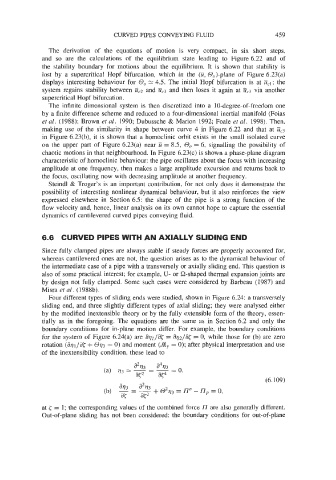Page 489 - Fluid-Structure Interactions Slender Structure and Axial Flow (Volume 1)
P. 489
CURVED PIPES CONVEYING FLUID 459
The derivation of the equations of motion is very compact, in six short steps,
and so are the calculations of the equilibrium state leading to Figure 6.22 and of
the stability boundary for motions about the equilibrium. It is shown that stability is
lost by a supercritical Hopf bifurcation, which in the (2, @,)-plane of Figure 6.23(a)
displays interesting behaviour for 0, 2 4.5. The initial Hopf bifurcation is at 2,l; the
system regains stability between Uc2 and Uc3 and then loses it again at 2,3 via another
supercritical Hopf bifurcation.
The infinite dimensional system is then discretized into a 10-degree-of-freedom one
by a finite difference scheme and reduced to a four-dimensional inertial manifold (Foias
et al. (1988); Brown et al. 1990; Dubussche & Marion 1992; Foale et al. 1998). Then,
making use of the similarity in shape between curve 4 in Figure 6.22 and that at Uc3
in Figure 6.23(b), it is shown that a homoclinic orbit exists in the small isolated curve
on the upper part of Figure 6.23(a) near U = 8.5, 0, = 6, signalling the possibility of
chaotic motions in that neighbourhood. In Figure 6.23(c) is shown a phase-plane diagram
characteristic of homoclinic behaviour: the pipe oscillates about the focus with increasing
amplitude at one frequency, then makes a large amplitude excursion and returns back to
the focus, oscillating now with decreasing amplitude at another frequency.
Steindl & Troger’s is an important contribution, for not only does it demonstrate the
possibility of interesting nonlinear dynamical behaviour, but it also reinforces the view
expressed elsewhere in Section 6.5: the shape of the pipe is a strong function of the
flow velocity and, hence, linear analysis on its own cannot hope to capture the essential
dynamics of cantilevered curved pipes conveying fluid.
6.6 CURVED PIPES WITH AN AXIALLY SLIDING END
Since fully clamped pipes are always stable if steady forces are properly accounted for,
whereas cantilevered ones are not, the question arises as to the dynamical behaviour of
the intermediate case of a pipe with a transversely or axially sliding end. This question is
also of some practical interest; for example, U- or Q-shaped thermal expansion joints are
by design not fully clamped. Some such cases were considered by Barbeau (1987) and
Misra et a1. (1988b).
Four different types of sliding ends were studied, shown in Figure 6.24: a transversely
sliding end, and three slightly different types of axial sliding; they were analysed either
by the modified inextensible theory or by the fully extensible form of the theory, essen-
tially as in the foregoing. The equations are the same as in Section 6.2 and only the
boundary conditions for in-plane motion differ. For example, the boundary conditions
for the system of Figure 6.24(a) are aql/a( = ar/2/a< = 0, while those for (b) are zero
rotation (aql/a( + 0113 = 0) and moment (A, = 0); after physical interpretation and use
of the inextensibility condition, these lead to
at < = 1; the corresponding values of the combined force l7 are also generally different.
Out-of-plane sliding has not been considered: the boundary conditions for out-of-plane

